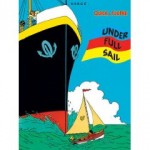
By Hergé, translated by David Radzinowicz (Egmont UK)
ISBN: 978-1-4052-4743-6
Finally making it into English are the adventures of two young scallywags that for a while rivalled the utterly irresistible Tintin in popularity and ones which certainly acted as a test lab for the humorous graphic elements so much a part of the future world classic.
Georges Prosper Remi, known all over the world as Hergé, created a genuine masterpiece of graphic literature with his tales of a plucky boy reporter and his entourage of iconic associates, but Tintin was by no means his only creation. Among the best of the rest are Jo, Zette and Jocko and these episodic all-ages comedy gems.
On leaving school in 1925 Hergé worked for the Catholic newspaper Le XXe Siécle where he seems to have fallen under the influence of its Svengali-like editor Abbot Norbert Wallez. A dedicated boy-scout himself, he produced his first strip series The Adventures of Totor for Boy Scouts of Belgium monthly magazine the following year, and by 1928 he was in charge of producing the contents of Le XXe Siécle‘s children’s weekly supplement Le Petit Vingtiéme.
He was unhappily illustrating The Adventures of Flup, Nénesse, Poussette and Cochonette, written by the staff sports reporter, when Abbot Wallez asked him to create a new adventure series. Perhaps a young reporter who would travel the world, doing good whilst displaying solid Catholic values and virtues?
Having recently discovered the word balloon in imported newspaper strips, Remi decided to incorporate the innovation into his own work. He would produce a strip that was modern and action-packed. Beginning on January 10th 1929, Tintin in the Land of the Soviets<; appeared in weekly instalments in Le Petit Vingtiéme running until May 8th 1930.
At about this time he also began crafting the weekly 2-page exploits of two working class rapscallions in Brussels who played pranks, got into mischief and even ventured into the heady realms of slapstick and surrealism in the kind of yarns that any reader of Dennis the Menace (ours, not the Americans) would find fascinatingly familiar.
Originally running in black and white in Le Petit Vingtiéme starting in January 1930 they larked about for over a decade until the war and the pressure of producing Tintin meant they had to go. They were rediscovered in 1985 and their collected adventures ran for 12 volumes.
Now we’ve got them, available for folk too lazy to learn French (or Dutch or German or…) in a glorious full-colour make-over and they are the perfect light read for kids of all ages.
© Hergé – Exclusivity Editions Casterman 1986. All Rights Reserved.
English translation © 2009 Egmont UK Limited. All Rights Reserved.
